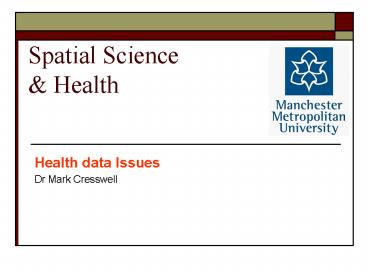Spatial Science - PowerPoint PPT Presentation
1 / 31
Title:
Spatial Science
Description:
Title: EG3213 Spatial Science & Health Author: Dr Mark Cresswell Last modified by: Mark Cresswell Created Date: 10/15/2005 3:06:09 PM Document presentation format – PowerPoint PPT presentation
Number of Views:68
Avg rating:3.0/5.0
Title: Spatial Science
1
Spatial Science Health
- Health data Issues
- Dr Mark Cresswell
2
Topics
- Who compiles health data?
- Medical ethics
- Anonymised case records
- Disease summary statistics
- Problems human
- Problems technical
- Examples of public-access health data
3
Who compiles Health Data?
- General practitioners
- Patient records
- Hospitals
- Mortality, morbidity and rehabilitation
- Local health authorities
- National health ministry (NHS in UK)
- World Health Organization
- Regional and World
4
UK Health Data
- UK National Health Service was set up in 1948
- It is the largest organisation in Europe
- The NHS is funded by the taxpayer and managed by
the Department of Health, which sets overall
policy on health issues
5
NHS structure in England (Source NHS, 2006)
6
Global Health Data?
- World Health Organization (WHO)
- Established in 1948
- Based in Geneva
- Part of the United Nations Infrastructure
The attainment by all peoples of the highest
possible level of health Health is defined in
WHO's Constitution as a state of complete
physical, mental and social well-being and not
merely the absence of disease or infirmity.
7
Global Health Data?
- The WHO is governed by 192 states which together
make up the World Health Assembly - Main tasks for the assembly are to
- Approve the WHO programme
- Monitor and approve the WHO budget
- Decide key policy issues
8
General WHO Administrative Structure
9
Who compiles Health Data?
- Universities
- Medical research
- Census and health economics
- Drug (pharmaceutical) companies
- NGOs (Médecins sans Frontières and IRC)
- Charitable donors (BM Gates Foundation)
10
Who compiles Health Data?
- Non Governmental Organisations may operate under
special circumstances - Third World countries
- Areas affected by natural disasters or war
- Diseases and conditions poorly under resourced
- Action paid for by existing medical charities
- Politics!
11
Medical Ethics
- Personal data must be regarded as strictly
confidential at all times (GP data) - Even today, data is transferred to/from hospitals
by taxi (no digital system yet) UK - Studies may use anonymised case data
- Unless drug trials
- Unless prior consent in focus study
12
Anonymised case records
- Data may be released to scientific community for
research purposes - Personally identifiable portions of GP/hospital
records is stripped out (name, address and maybe
date of birth) - Most records contain standard record information
(age, sex, prior history, illness, duration of
illness, location, date etc)
13
Disease Summary Statistics
- Specific diseases may be characterised by
collating and summarising case data - Many diseases are grouped by theme and coded
- Medical statistics are employed to help analyse
spatial and temporal change in disease - Prevalence, morbidity, mortality etc are the
common currency of epidemiologists
14
Problems Human
- Social inequality and marginalised people
- poverty or caste/class/race divides
- Taboo and embarrassment
- STDs and prostate/breast cancers
- Mis-diagnosis (poor equipment or training)
- Similarity of symptoms no lab facilities
- Poor reporting or surveillance infrastructure
15
Problems Human
WHO vaccination campaign
Burkina Faso Epidemiological
Surveillance
16
Problems Technical
- Diagnostics
- Time consuming
- Lab-on-chip technology expensive
- Complex vector dynamics
- E.g. Bird flu (migratory patterns)
- Refugee and nomadic populations
- Use of satellites to track people
- Loss of medical records by displaced people
17
Saharan dust storm March 2004 (MODIS)
18
Disaster Monitoring Constellation (DMC) is a new
series of geostationary satellites developed
specifically for disaster applications including
health.
DMC 26 or 32m resolution. Sun-synchronous
A relatively cloud free image was available for
the period 1012 GMT on 13/6/05. A water body was
identified (LAT 13.054N, LON 2.070W). All three
spectral channels (NIR, RED and GREEN) were
sampled across a transect line bisecting the
water body
19
(No Transcript)
20
(No Transcript)
21
- Interpolation of sparse station readings is
undesirable so we must look to - Remote sensing
- Model output
ABOVE Model grid representation LEFT Meteosat
weather satellite
22
(No Transcript)
23
European health data
- The WHO regional office for Europe provides
access to country-specific health and disease
statistics via the centralized information system
for infectious diseases (CISID). This is
available from - http//data.euro.who.int/cisid/.
- Health for All database
- http//www.euro.who.int/hfadb
24
European health data
CISID data example
25
European health data
HFA data example
26
African Malaria Data
MARA data
27
African Meningitis Data
MSF and MALSAT
Spatial Distribution Meningitis Epidemics
1841-1999 (n c.425) 1
1 Molesworth A.M., Thomson M.C., Connor S.J.,
Cresswell M.P., Morse A.P., Shears P., Hart C.A.,
Cuevas L.E. (2002) Where is the Meningitis Belt?,
Transactions of the Royal Society of Hygiene and
Tropical Medicine, 96, 242-249.
28
WHO compile case statistics reports on a regular
basis in a standard format
29
WHO compile case statistics reports on a regular
basis in a standard format
30
WHO compile case statistics reports on a regular
basis in a standard format
31
ANY QUESTIONS





























![[PDF] Spatial Analysis in Epidemiology Kindle PowerPoint PPT Presentation](https://s3.amazonaws.com/images.powershow.com/10100097.th0.jpg?_=20240816055)

